








 |
Contact Us | Location | About Us | Pricing | T's & C's | ||||||||
 |
 |
 |
 |
 |
 |
 |
 |
||
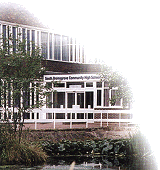 South Bromsgrove Community High School
South Bromsgrove Community High School| School: | South Bromsgrove Community High School |
| Address: | Charford Road, |
| Tel: | 01527 831783 |
| Fax: | 01527 837162 |
| Email: | sbhs@rmplc.co.uk |
| Website: | http://www.southbro.worcs.sch.uk |
Snapshot of the School:South Bromsgrove Community High School is situated in an attractive setting in green-belt land on the outskirts of the town. There are 1200 students on role with a sixth form of 250. The curriculum is delivered to the students by a staff of 100 teachers. The School is a co-educational community school with an intake of students from 13 to 19 years of age. It has a proud heritage and exciting future plans. Standards of work and behaviour are good as is the appearance of the students.
South Bromsgrove Community High School became a Technology College in 1999. The Technology department has formed the springboard for links with local industries other schools and the local community. The school has a new ICT centre in addition to three existing computer suits. There are computers within each curriculum area and the Resource Centre and 6 th Form Centre are available for students to use the School intranet at any time.
The School intranet system allows students to log on to any curriculum area and find information on that subject, homework and coursework tasks and are provided with learning activities to supplement their studies. All students have their own e-mail address and manage their own user areas. Teachers encourage use of technology as a learning tool and at Key Stage 4 all students take accredited ICT courses. 200 state-of-the-art wireless linked laptops enhance delivery of the curriculum and a lease plan allows 6 th form students to purchase their own laptops and continue to use them at university.
The Technology curriculum is delivered by eight full-time members of staff and they are supported by one technician. Within this area of the curriculum some very interesting work is undertaken by students who follow the OCR course in Design and Technology (Industrial Technology) and the case study that follows looks at students undertaking study in that focus area. The Technology curriculum is delivered by eight full-time members of staff and they are supported by one technician. Within this area of the curriculum some very interesting work is undertaken by students who follow the OCR course in Design and Technology (Industrial Technology) and the case study that follows looks at students undertaking study in that focus area.
Range of D&T GCSE’s offered: A full range of GCSE’s at Key Stage 4 and OCR examination in Industrial Technology.
Number of teachers teaching D&T: 7 teachers most of whom are specialists in their own curriculum area.
How is ICT for D&T Resourced? From the department’s capitation and by special bids presented to senior management team.
How much ICT training have members of the D&T dept had? Variable - most ICT development is provided by training from the National ProDesktop initiative. The remainder is done through an internal INSET provision.
Brief history of ICT development: Department is well resourced, but all members of staff are not familiar with all the ICT facilities available.
Date of Case Study: September 2001
The Case Study: The Design and Technology culture in the school is strong. For this case-study we look at the development of students work leading to the OCR GCSE in Design and Technology (Industrial Technology).In the first photograph we see year 10 students, in the first few weeks of their course, all highly involved in their projects and highly motivated toward their study.

The teaching environment is light, airy and friendly. Staff are supportive and the students proud of their work and proud of the quality of their outcomes. The next photograph shows a student who had only been on the course for 4 weeks (with no prior subject knowledge) keenly engaged with her project and with a highly engineering product almost completed.

Student interaction is good. Students are encouraged to discuss their progress with each-other and as we see from the next photograph this approach pays its dividends in terms of classroom motivation.

All this preliminary work provides students with the skills and knowledge base to prepare them for their GCSE in Industrial Technology.
Nature of Coursework: Candidates are required to produce an Industrial Technology product that can be marketed. The underlying influence on the project should be that the product will be the first of a batch of 50 realised in the school with the facilities that are available. The student will realise the first, or prototype of this product.
The evidence to be submitted for assessment must include a 3 dimensional device with a concise portfolio (including evidence of modelling) and /or appropriate ICT evidence. Centres are reminded that ICT evidence must address the requirements of the six Internal Assessment objectives. Evidence which does not lead to a finished product can be assessed if it is felt that it represents work appropriate to the focus of the project.
The six Internal Assessment objectives are:-
The OCR examination board strongly point out to centres that the coursework presented for assessment will represent 40 hours of work for the full GCSE course and add that some of the work, by its very nature, may be undertaken outside of school e.g research work, testing etc..
Six coursework tasks are provided by OCR for candidates to attempt. Some schools offer all six to their students, but at South Bromsgrove because of equipment limitations and timetabling constraints they have decided to offer one task, task three, to their students.
Task Three. A Hole Punch for Sheet Aluminium: Candidates are required to design and make a hand operated hole punch for aluminium that can be used by Key Stage 3 pupils in schools to enable them to make their own ‘bolt together’ modelling kit.
Schools are provided with points to consider to ensure that candidates are assisted towards a sound start. These points are:-
Some Outcomes: The series of thumbnails that follow show some the outcomes from the student cohort examined at the end of the academic year 2000/2001.
 |
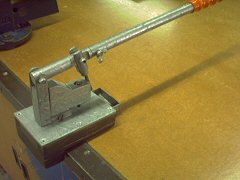 |
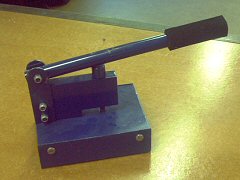 |
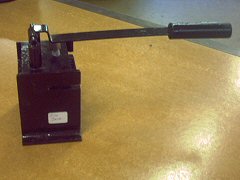 |
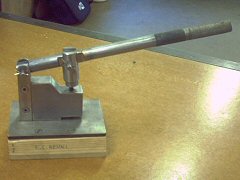 |
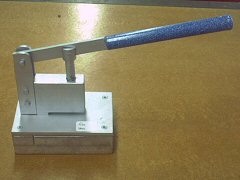 |
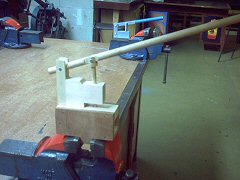 |
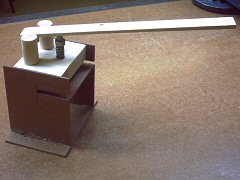 |
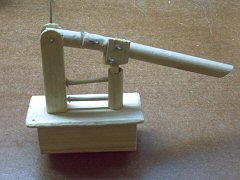 |
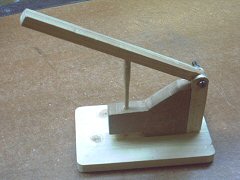 |
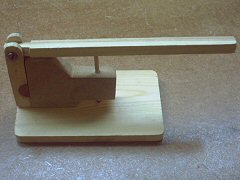 |
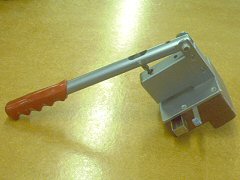 |
Supporting the Initiative: Part of the philosophy of the department is the holistic approach to D&T. Staff wish to see students being able to have transferable skills that can integrate between all areas of D&T. As such they see CAD/CAM skills as being an important part of the process and have invested heavily in a Boxford CAM manufacturing centre the work done here is supported by ProDesktop. The staff see these ICT skills as an important function of the skills base that is supplied to the students in readiness for their GCSE course. The photographs that follow give a snap-shot of students working at the CAD/CAM manufacturing centre and a typical outcome that is undertaken by all the students in preparation for their OCR GCSE.
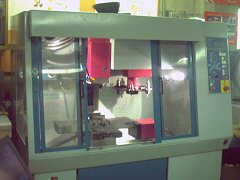 |
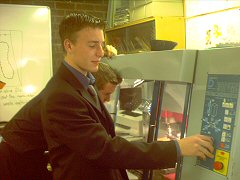 |
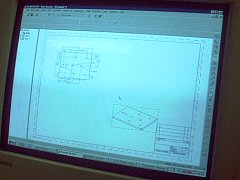 |
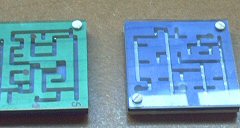 |
Outcomes from two students: As noted earlier, in the holistic approach adopted at South Bromsgrove, the whole ICT in D&T experience is important to staff and students alike. The following examples follow two students, Colin and James, as they undertake their ICT work in their journey toward their final artefact.
James' Work
 |
 |
 |
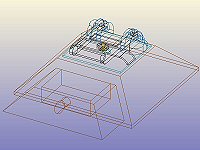 |
Colin's Work
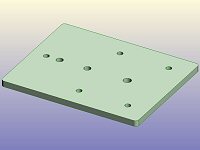 |
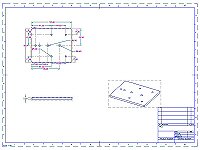 |
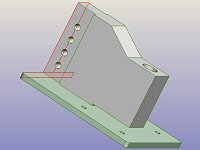 |
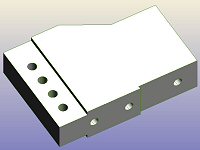 |
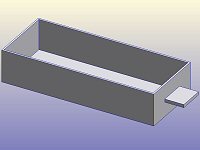 |
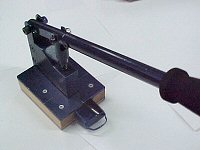 |
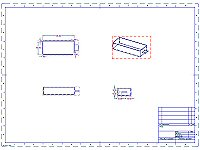 |
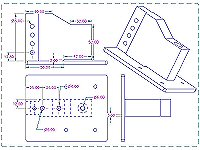 |
Conclusion: The work observed at South Bromsgrove, was remarkable. Motivation in the department was exceptional and the expectations of staff and students alike was very high. This is a “lead by example” school. The headteacher, Mr. PC McTague, believes in the school and supports the ICT and D&T work that is going on in this Community High School. We mention earlier about the wireless network in the sixth form centre and the way that all the sixth form students are encouraged to lease a laptop from the school – a laptop that students may then take with them into Higher Education. The next 2 thumbnails provide a view of one of the general ICT suites and students working in this highly resourced area.
 |
 |
The work going on in this D&T department is amazing. It was a pleasure to undertake this case-study and report on how this has happened in such a short period of time. This is a story of belief and commitment and emphasises what can be achieved if the departmental policy and methods of delivery are correct.
Teacher observed during the case study: Mr Shawn Mullinder
GCSE focus area for this study: Oxford Cambridge and RCA Examinations GCSE In Design and Technology (Industrial Technology) Syllabus 1959.
Number of D&T rooms: 5
No of students in group & boy/girl split: 24: 13 boys & 11 girls.
Band/stream/mixed ability: Mixed ability
ICT resources: ICT facilities in the department are limited. The workshop buildings are quite old, but well resourced with general D&T equipment. ICT facilities in the rest of the college are good and are bookable by members of the D&T team.
Teacher INSET: Teacher INSET is identified by members of the team making a case to the HoD. Provision is then provided on the grounds of available money and the needs of delivering the curriculum during that year.
Teacher support: Departmental support is provided by a general technician who comes from an engineering background. This technician also supplies the ICT support.
Differentiation – learning support and EFL support: As mentioned earlier tasks for this course are provided by OCR. Some schools offer all six to their students, but at South Bromsgrove because of equipment limitations and timetabling constraints they have decided to offer one task to their students. Differentiation is by outcome.
The future: To make a bid to senior management for enhancement of the facilities.
© Amethyst Consultancy. 2004-2020
For all products and systems designed by us on behalf of our clients the company's terms and conditions apply.